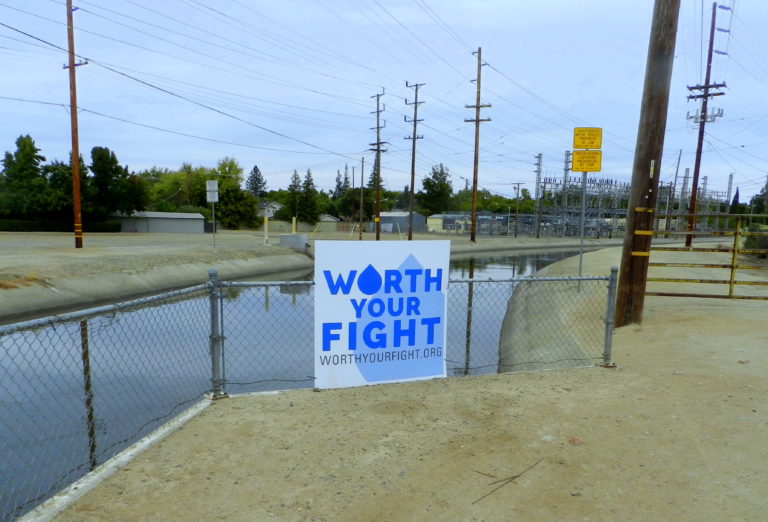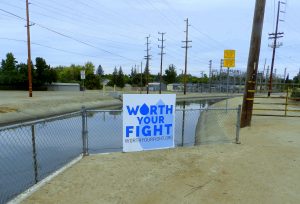

Though there’s no truth to the rumor people have been painting it brown, the water drop on the “Worth your Fight” sign produced by the Turlock and Modesto Irrigation Districts could just as easily be an almond. And if it were so portrayed, it would certainly present a more accurate picture as leaders throughout the San Joaquin Valley protest state proposals to increase flows along valley rivers.
Water, of course, is worth anyone’s and everyone’s fight. And that’s their real problem, as Valley politicians tie themselves in logical knots trying to explain why they deserve, more than anyone else, the water everyone needs—especially since almonds aren’t exactly on everyone’s list of basic food requirements.
Almonds are, however, leading consumers of Valley water, and they’re consuming more every day as the rush to plant new trees continues unabated, even during a historic drought. Thus, when defending regional water consumption, the default ag position, “our economy depends on it,” isn’t any different than anyone else’s would be except that the volumes of water involved are so huge.
Farming uses about 80% of water used by businesses and homes, and the grand total of both as far back as 2010 was over 13 trillion gallons. Anyone even remotely aware of the figures has to wonder about the return on investment from such staggering consumption of a public resource.
In dollars, the return is huge. In 2015, California ag production amounted to approximately $47 billion. But big as it is, taken as a percentage of the state’s total gross domestic product, agriculture amounts to only around 2%.
Boosters of agriculture’s manifold economic benefits like to cite the “multiplier factor” when defending ag’s inordinate percentages of water consumption, and they have a point. Agriculture generates related jobs and business and assuredly adds more to the economy than just its gross production. But so does any other business, including commercial fishing, making semiconductors, tourism, etc.
And in what amounts to a bizarre and contradictory position, some Valley leaders cite widespread poverty as yet another reason we can’t afford increased flows in our rivers. But the poverty throughout the San Joaquin Valley is just another sign that profits from the ag-based economy, despite its gargantuan water consumption, don’t trickle down, even including the multiplier factor.
Almost as prevalent as the “Worth your Fight” slogan are the widespread references to the “Regulatory Drought.” On first sight, this slogan looks like denial altogether that there even was a drought, and certainly that seemed to be Donald Trump’s position when he visited the Valley last year.
The assumption here is that there’s plenty of water but the state is simply playing favorites and denying water to those who most deserve it. Though science, historical data, and expert testimony all discredit this premise, none of these matter to the slogan-mongers. In the post-truth era, a catchy slogan, especially one that implies vast conspiracies, is far more credible than unpleasant facts. Again, see Donald Trump.
So assuming it’s looking beyond slogans and the kind of provincialism that says, “we need the water more than you do,” what is the state to do? Maybe we can all learn a lesson from the demise of the mighty Colorado River, which is now diverted far beyond capacity as it serves 70 million people and 3.5 million acres of farmland. Like our own local rivers, the Colorado simply can’t deliver enough water to meet demands.
Even more telling is the current state of the Colorado River Delta, which Aldo Leopold said in 1922 sustained, “a wealth of fowl and fish,” in “still waters of a deep emerald hue.” Today, since the Colorado rarely reaches the sea, its delta is a forlorn waste of invasive plants and mud flats. Even the Gulf of California, into which the Colorado once poured billions of gallons of life-giving fresh water, has seen precipitous declines in populations of shellfish, shrimp, and waterfowl.
The time when increased flows along the Colorado River could have benefitted a broader range of uses is long past. Time will tell whether California and Valley residents experience the same tragedy with their own rivers and delta. Like the rivers themselves, the San Joaquin Delta and the San Francisco Bay also need fresh and flowing water.
State officials face the difficult task of weighing the undeniable bounty from almond production against a far broader range of long-term public benefits. It’s a thankless task, but one that requires a broad concept of the commonweal. Water is for everyone.
[…] Are the arguments for Valley water full of holes? Eric Caine writes, “Though there’s no truth to the rumor people have been painting it brown, the water drop on the “Worth your Fight” sign produced by the Turlock and Modesto Irrigation Districts could just as easily be an almond. And if it were so portrayed, it would certainly present a more accurate picture as leaders throughout the San Joaquin Valley protest state proposals to increase flows along valley rivers. Water, of course, is worth anyone’s and everyone’s fight. And that’s their real problem, as Valley politicians tie themselves in logical knots trying to explain why they deserve, more than anyone else, the water everyone needs—especially since almonds aren’t exactly on everyone’s list of basic food requirements. … ” Read more from the Valley Citizen here: Are the arguments for Valley water full of holes? […]
Actually Eric I think the argument you made above is full of holes so much so I could drive Arnold’s hummer through them all.
Comments are closed.